How to Sell on Walmart With Shopify to Reach More Markets

If you’re looking to scale your Shopify store, selling on Walmart.com can be a smart sales strategy for rapid growth.
In addition to more traffic and a broader customer base, Shopify has a partnership with Walmart so merchants can seamlessly link their Shopify stores to the Walmart Marketplace.
It’s an easy and effective way to reach customers beyond Shopify.
Selling on Walmart Marketplace means more consumers discovering your products, better brand recognition as shoppers get accustomed to seeing your brand everywhere, and enhanced brand recall.
Hence, shoppers search for your brand directly the next time they shop.
In this article, we’ll go over:
#cta-visual-pb#<cta-title>Build landing pages that convert<cta-title>Create product pages that convert—no matter where shoppers come from—with Shogun Page Builder.Start designing for free
What is Walmart Marketplace?
Walmart needs no introduction.
Until recently, it was the largest global retailer outside of China, and it remains the top omnichannel marketplace in the world.
Walmart Marketplace is their ecommerce arm.
It’s a sales platform built for merchants to integrate their product catalog, manage orders, arrange shipments, and deliver customer service.
Why you should sell on Walmart Marketplace

You’ve invested time, energy, and resources into creating your Shopify store, so it’s natural you want to expand its reach.
Although counterintuitive, selling on another channel is an effective strategy, especially as you scale your business.
Omnichannel sales are critical in today’s ecommerce environment as consumer expectations grow and merchants must find a way to provide a seamless customer experience.
When you sell on Walmart Marketplace, you sell to a vast customer base that already uses the platform. Simply by becoming a seller on Walmart Marketplace, you’re leveraging Walmart’s brand value.
This increases your brand authority, which helps customers feel more confident when choosing your products.
Plus, with no set-up or monthly fees, Walmart Marketplace is an affordable option for merchants—you simply pay a referral fee per sale.
What are Walmart referral fees?
Referral fees are a percentage of the sales you make on Walmart Marketplace.
Walmart’s referral fees range from 6% to 20%, depending on the category you sell in.
For example, as of this writing, personal computers have a referral fee of 6%. That means if you sell a laptop, your referral fee will be 6% of the sales price.
On the other hand, video games have a 15% referral fee, which means when you sell a video game, you will owe 15% of your item price.
Expand your consumer reach
Even the most beautifully laid out Shopify store with must-have items needs to invest in customer acquisition and ads.
However, you can take advantage of Walmart’s enormous daily traffic and land your products in front of more shoppers simply by being in the Marketplace app.
All Walmart.com shoppers who search for brands or products are potential customers, with up to 100 million unique users each month.
As you grow your reach on Walmart Marketplace and expand your product recognition, consumers will eventually begin to recall your brand when they think about repurchasing, leading to more DTC sales as well.
Tap into a fast-growing ecosystem as an early adopter
Fun fact: Did you know Shopify was Walmart’s first-ever commerce platform partner?
Tapping into Walmart Marketplace now is similar to investing in real estate—it’s better to get in early.
In July 2021, Walmart Marketplace surpassed 100,000 sellers, nearly double the number of those registered in July 2020. Statista data demonstrates a steady pattern of growth even before the COVID-19 pandemic.
By joining this fast-growing ecosystem now, you’ll enjoy the benefits of being a part of a large marketplace.
The earlier you join, the less competition you have for the items in your catalog.
That allows you to get a head start collecting reviews so that whenever your competitors eventually sign up, your products will already have a healthy amount of reviews ahead of them.
Leverage their retail stores for greater presence
According to research from Shopify, 54% of consumers are likely to look at a product online and buy it in-store, while 53% are likely to look at a product in-store and buy it online.
This emphasizes the importance of having both an online and physical presence.
When you work with Walmart Marketplace and find your products resonating with the Walmart audience, you might also explore opportunities with your account manager to be stocked on Walmart shelves for consumers who prefer to buy online and pick up in-store.
Access marketplace resources to boost conversions
Walmart has been around for many years, and in that time, the company has built an impressive infrastructure that individual merchants can’t beat.
Once you become an approved seller, you’ll gain access to Walmart Marketplace seller resources that help you boost conversions and grow your business.
1. Fast and free shipping
Offering free one- and two-day shipping costs you as an individual merchant, but consumers now expect this speedy service.
Through Walmart Marketplace, you can affordably offer your customers free two-day shipping.
Fast shipping increases conversions, reduces cart abandonment, boosts customer satisfaction, and helps you stand out.
2. Easy and secure transactions
If you’ve ever made a purchase on Walmart.com, you know their checkout process is hassle-free and secure.
Walmart has arguably set the standard for how retailers should create their checkout page.
The ease combined with words like “Secure Checkout” and the trust seal help customers feel safer, making them more likely to complete a purchase.
3. Advanced listing and analytics tools
Walmart offers sellers many options to integrate their existing inventory management tools with the platform.
They also provide their own listing tools so sellers can seamlessly manage their pricing, promotions, and inventory.
These tools enable sellers to optimize product listings for the best chance of selling.
4. Pro Seller badges
Top-rated sellers stand out with Walmart Marketplace’s Pro Seller badge, which highlights and rewards the best-selling merchants on the platform.
The Pro Seller badge is designed to be eye-catching in search results, thus increasing visibility for eligible merchants while simultaneously boosting customer confidence.

To earn Pro Seller status, you must meet several criteria, including:
- Delivery Defects rate of <10%
- Fewer than 2% order cancellations
- Listing Quality Score above 60% for a minimum of 70% of the trending catalog
- More than 100 orders closed within 90 days
- No Trust & Safety or Performance Standards violations
- Be active for at least 90 days
5. Sponsored products
Imagine if your product could be seen by millions of customers today to drive more discovery, sales, and growth.
With Walmart Marketplace’s Sponsored Product ads, you can highlight your products to help customers find exactly what they’re looking for.
These cost-per-click (CPC) ads help you scale up, are easily customizable, and provide campaign tracking so you can understand your campaign’s success and return on investment.
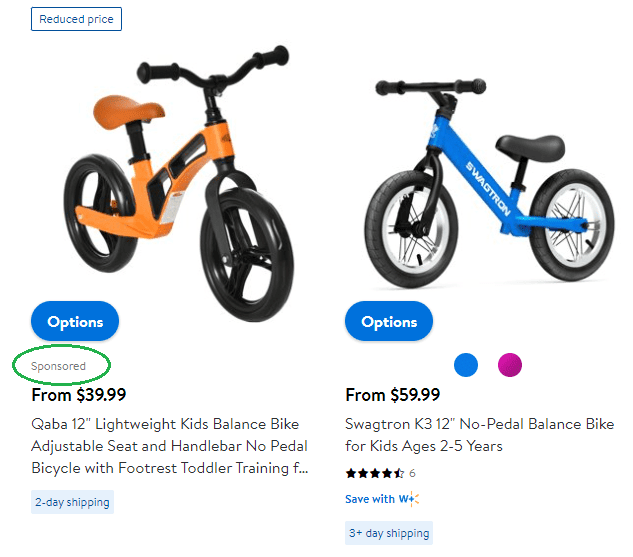
How to start selling on Walmart with your Shopify store
As previously mentioned, Shopify was the first ecommerce partner platform to integrate with Walmart Marketplace.
As a result, integrating your Shopify store with Walmart Marketplace is a seamless process.
Generally, to become a seller on Walmart Marketplace, merchants request to sell, get approval, and then begin selling.
But the process can look a little different for Shopify sellers, so let’s dive into the nitty-gritty of launching your Shopify store on Walmart Marketplace.
#cta-visual-pb#<cta-title>Wow your shoppers<cta-title>Craft websites that convert with Shogun Page Builder.Start building for free
A step-by-step process for signup and integration
Signing up for Walmart Marketplace and integrating your Shopify store is a relatively quick and easy process.
The hardest part? Waiting for approval and your first sale to roll in!
Here’s how to get started:
Step 1: Set up your Shopify store (if it’s not ready yet)
If you haven’t set up your Shopify store completely, now’s the time.
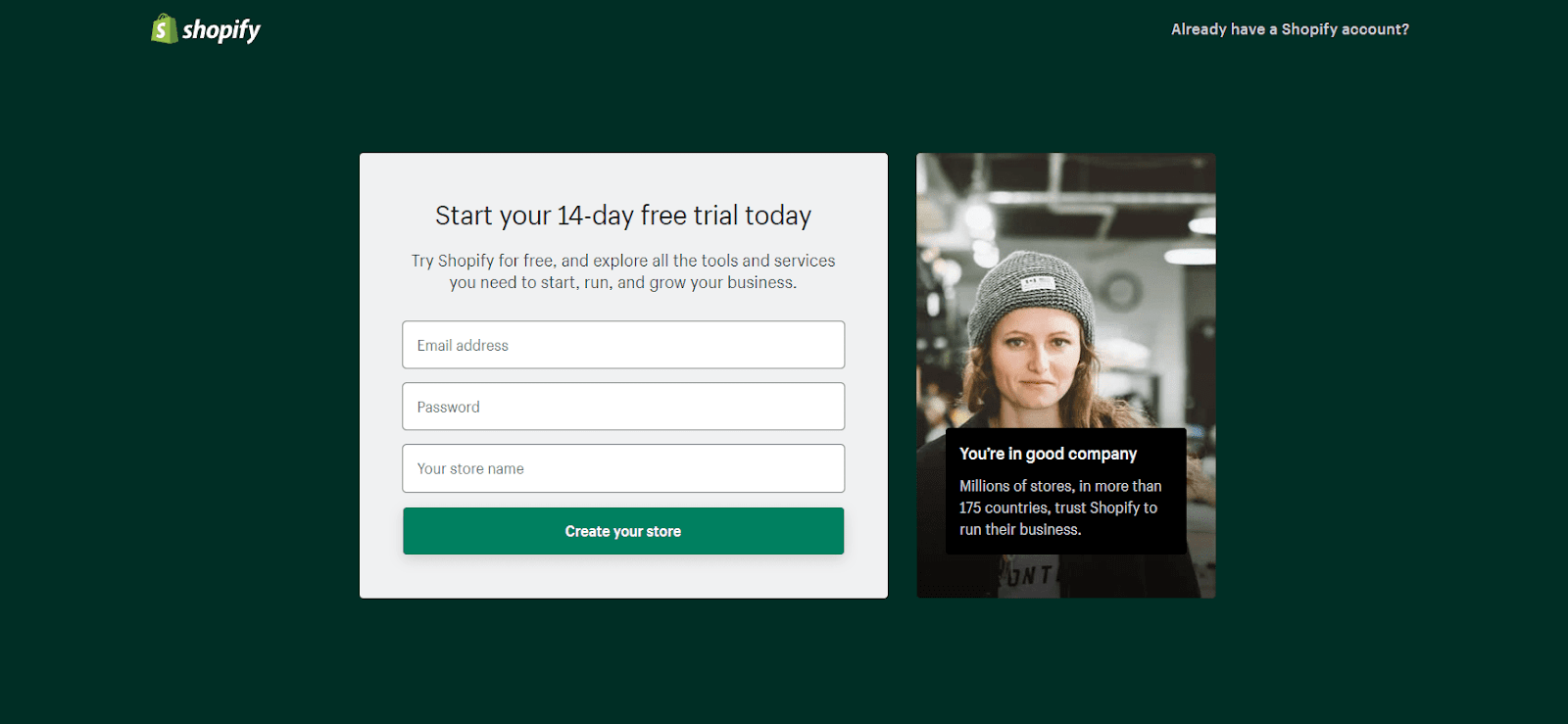
As an all-in-one solution, Shopify enables merchants to establish a fully functional store with no need for extensive tech experience.
It’s easy to sell your products, handle payments, manage fulfillment, and provide great customer service.
Shopify has oodles of great apps and tools available to help you build the best Shopify store for your brand.
Depending on your business, you might be looking at the regular Shopify plan (best for newbies, entrepreneurs, or small- to medium-sized businesses), or you might need Shopify Plus (best for enterprise brands, high-volume merchants, and large businesses).
Step 2: Set up your store on Walmart Marketplace
Once your Shopify store is ready to rumble, it’s time to apply to the Walmart Marketplace seller community.
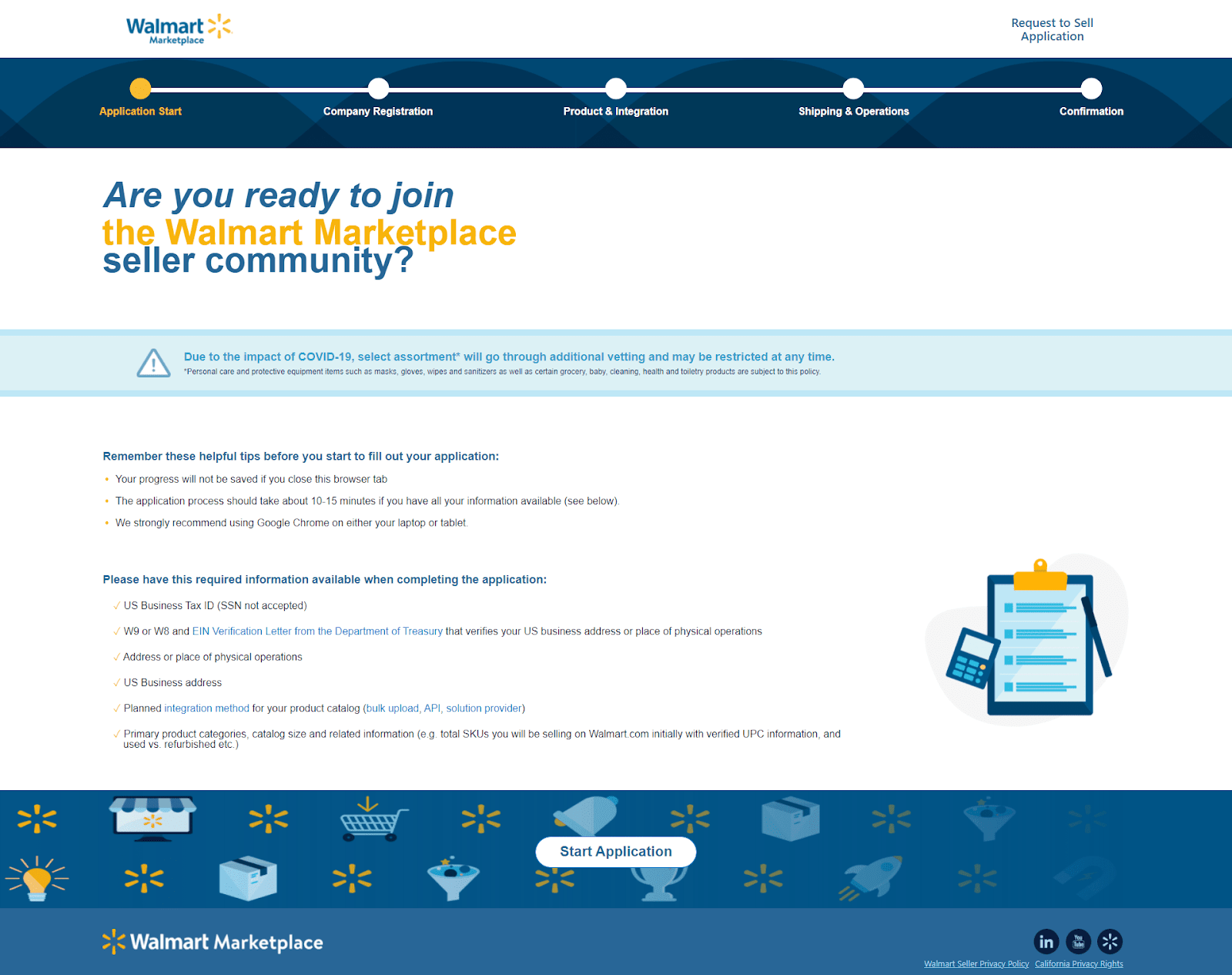
You’ll need to provide important details about your business, including:
- U.S. Business Tax ID (SSN is not accepted)
- W9 or W8 and EIN Verification Letter from the Department of Treasury verifying your U.S. business address or place of physical operations
- The address or place of physical operations
- U.S. business address
- Planned integration method for your product catalog (in this case, Shopify app integration)
- Primary product categories, catalog size, and related information (total number of SKUs you’ll be selling, verified with UPC information, used vs. refurbished information, etc.)
You’ll begin by filling out a standard information form with your personal and business information in the Company Registration section.
From there, you’ll fill out a Product and Integration section, where you’ll note whether or not goods are being transported from another country and which categories the items fall into.
Next, you’ll provide Shipping and Operations details explaining which shipping methods you currently use and your warehouse address.
Finally, you’ll explain why you would be a good fit for the Walmart Marketplace.
After you’ve filled out, reviewed, and finalized the forms, you’ll submit your request and wait one week for Walmart to approve your seller registration.
Step 3: Integrate the Walmart Marketplace app with Shopify
This is where the magic happens. Search for Walmart Integration in the Shopify App Store and select “Add App.”
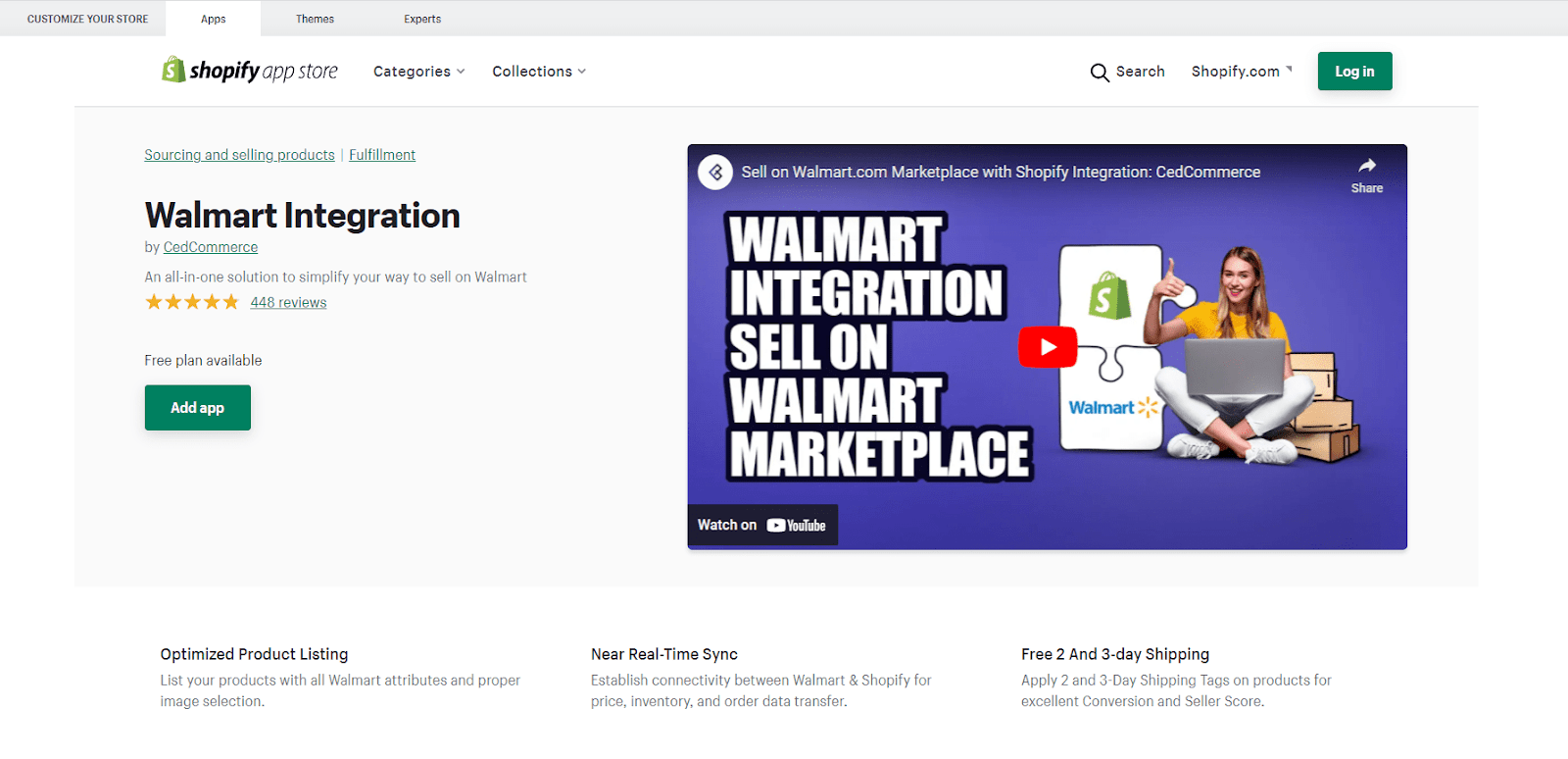
Provide your Shop’s URL and sign in.
Once you’ve installed the app, you can begin configuring it to your needs. With Client ID and Client Secret, the registration process is pretty simple.
You can begin importing products to Walmart once the registration process is complete.
For this, you can choose one of the three options under the Import Product Options section:
- All items available
- Products that are published
- Products that are filtered
Step 4: Customize your Walmart dashboard
It’s easy to set up the Walmart dashboard, and imperative you integrate it into your business management process.
Be sure to fill out the form in the Profiling area!
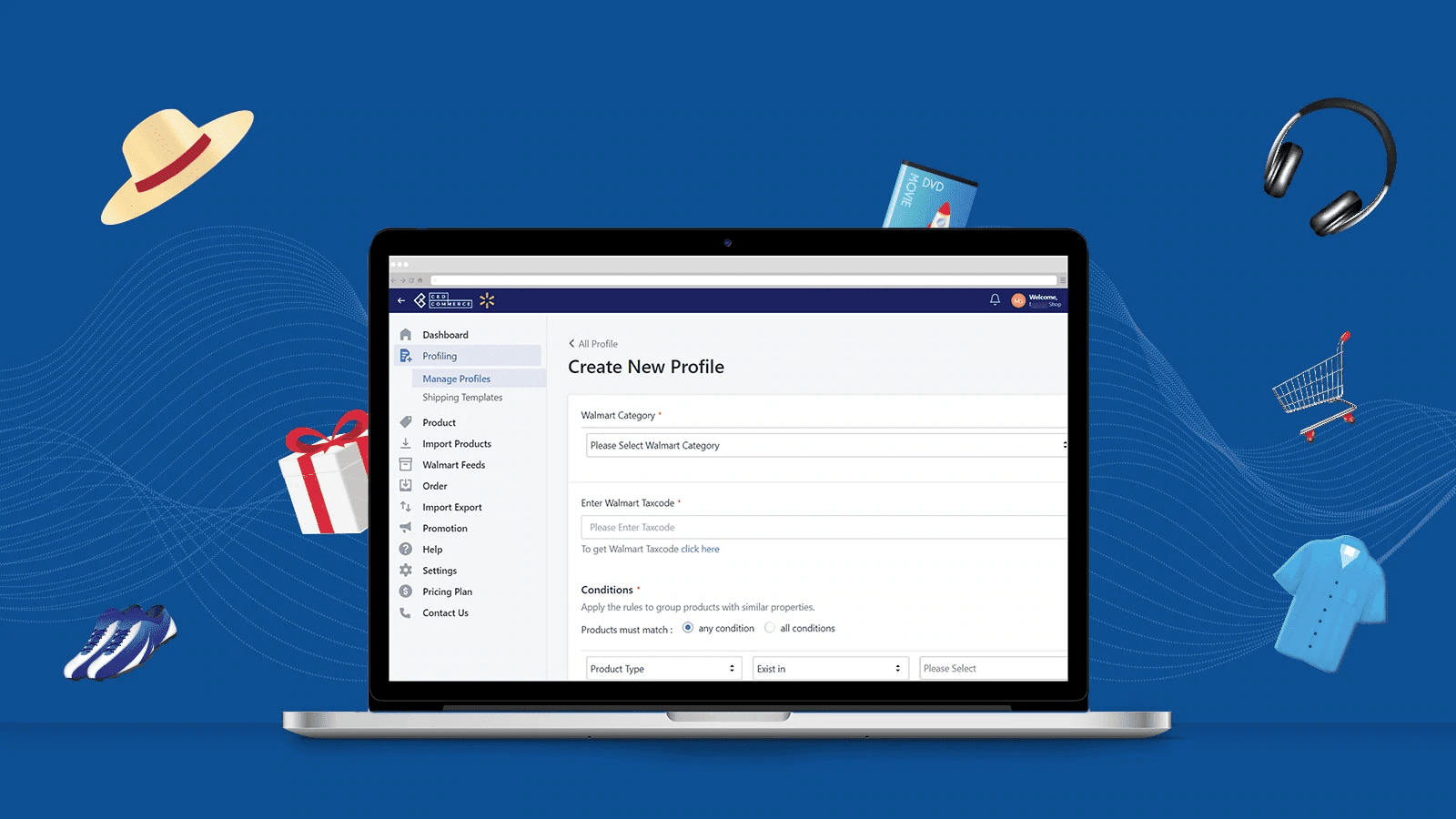
Once complete, so is your Walmart Shopify Integration. With the Shopify Walmart App, you can conveniently manage everything via your Shopify dashboard.
Best practices for selling on Walmart
After you’re all teed up to sell on Walmart, make sure you adhere to best practices to boost your chances of success.
Optimize your listings
Optimizing your product listings is critical to show up in search results, capture attention, and, of course, close sales.
1. Use a specific and succinct product name
Your product name should be 50-75 characters in length and be unique to your Walmart listing, meaning it’s not identical to your Shopify listing.
It can also be helpful to use defining features your customers may search for, such as color or size.
Here’s a simple formula to help you craft your product name:
Brand + Clothing Size Group (if applicable) + Defining Quality + Item Name + Style (if applicable) + Pack Count
2. Incorporate rich media, including product videos
No one wants to buy a product they know little about, which is why sellers should incorporate rich media with each product listing.
Merchants can add rich media and enhanced content to their product pages to showcase products in their best light.
For example, photos, charts, videos, and even nutritional information.
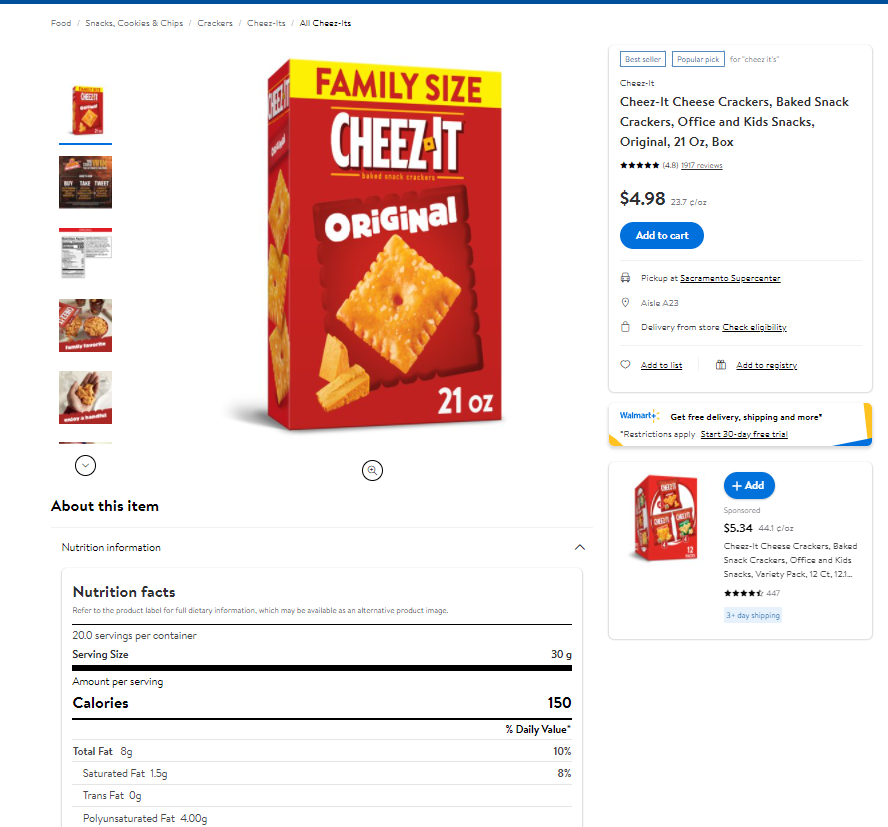
These graphics should be professional, in focus, and well-lit, and should not show accessories that are not included with the item.
You should provide at least four zoom-enabled, high-res images of the product, packaging, and any applicable accessories (ideally from different angles).
You can’t use placeholder images, photos that contain additional graphics or logos, watermarks, text, or overlays, and images must not be offensive or obscene.
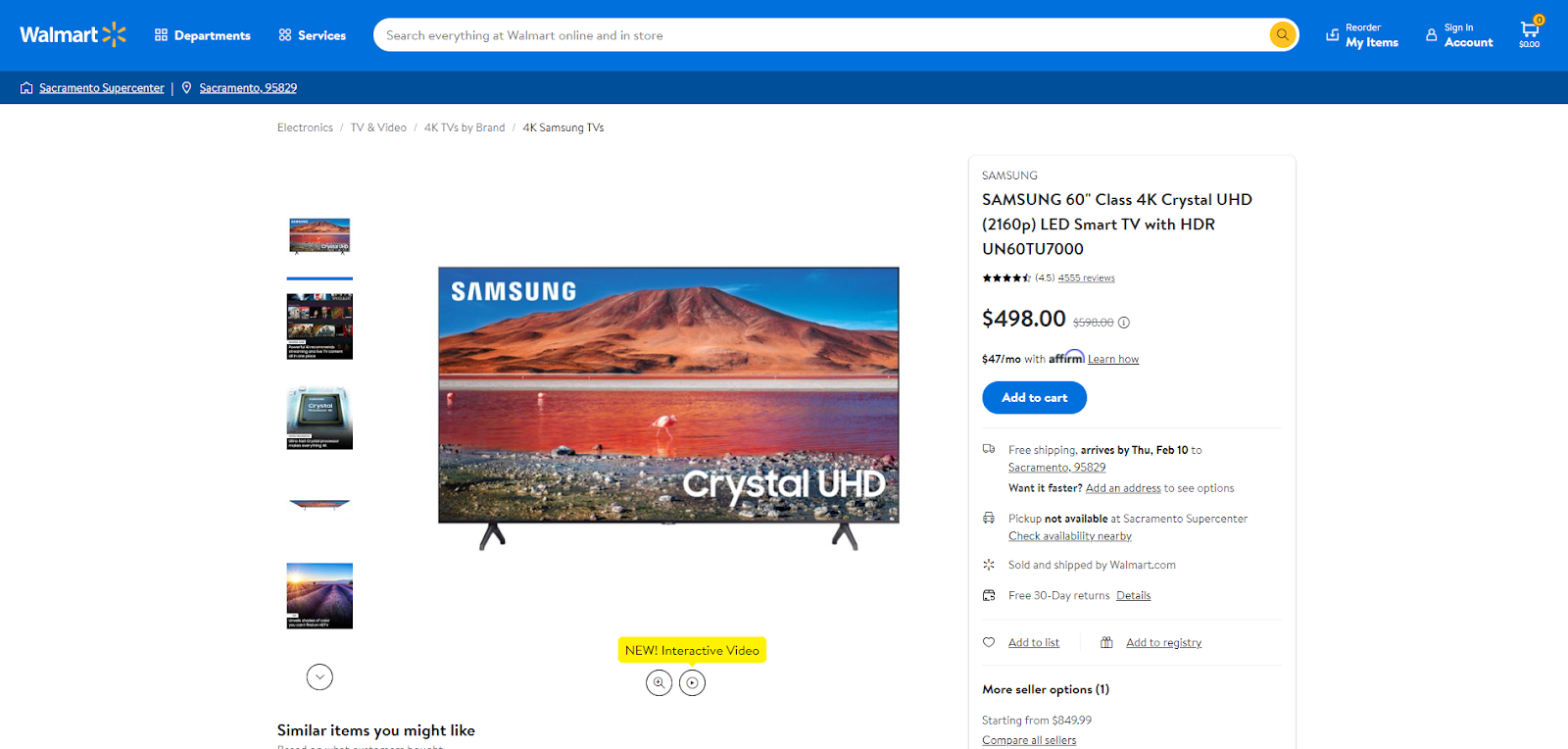
If a picture is worth a thousand words, a product video is worth ten times that.
Consider adding product videos to make your listings more exciting and to help your customers see products “in action.”
3. Offer fast and free delivery
You already know fast shipping is a great differentiator that helps boost conversions.
What you may not know is that Walmart Marketplace has a special one-day delivery and two-day delivery tag for listings where two-day shipping is available.
These fast shipping tags have been shown to boost conversions by 30% to 50% across the board.

4. Use keywords
Walmart SEO operates like all SEO—it’s what makes the search engine tick.
When selling on Walmart, it’s important to use keywords in your product title, product descriptions, alt text, and product attributes.
Using keywords like brand name, size, key features, and attributes will help your product listings appear organically when customers search for items like yours.
Leverage Walmart Fulfillment Services (WFS)
Walmart Fulfillment Services (WFS) is your ticket to two-day shipping and low-cost fulfillment on Walmart Marketplace.
When you leverage WFS, you instantly gain access to one of the world’s largest supply chains.
WFS provides full-service fulfillment for third-party sellers, reducing the strain of fulfilling orders in-house so you can scale faster.
Invest in reviews
Virtually all customers look at reviews before making a purchase, which is why it’s imperative to invest in them.
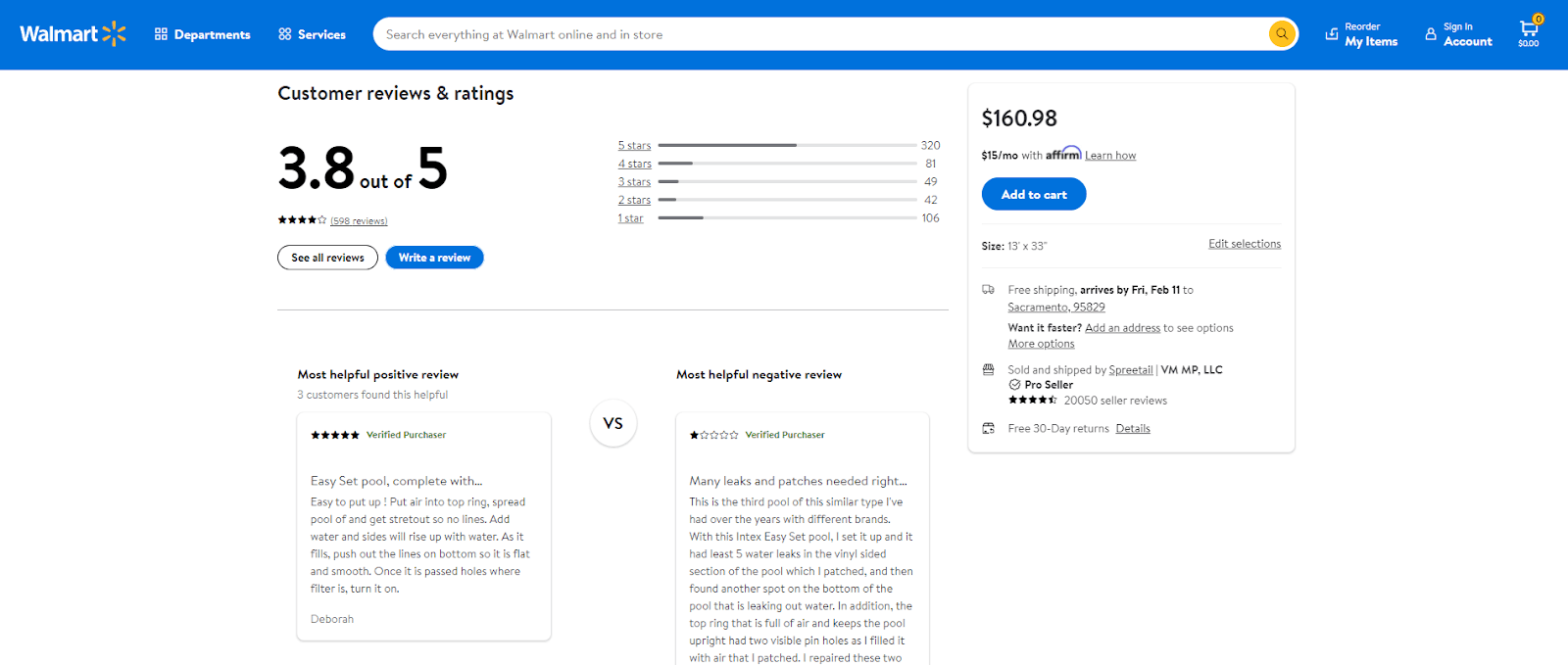
To generate more reviews on your products, build an email list and create drip campaigns requesting customers to share their feedback.
You can also use Walmart’s approved suppliers to aggregate your reviews from different platforms.
To increase the likelihood you’ll receive positive reviews, you have to provide a great customer experience from beginning to end.
If an issue arises, ask your customer for a review after you’ve successfully resolved it.
Keep your pricing competitive
Your best chance to win a Buy Box on Walmart Marketplace lies in having the most competitive prices.
Avoid a race to the bottom with value-added services, such as bundles (giving you a unique SKU) and fast shipping tags alongside competitive pricing.
Tip: Don’t just look at what others are charging. Always consider your own costs when determining price and what you can afford to charge.
Stay on top of inventory
Another way to win the Buy Box on Walmart Marketplace is to keep your inventory levels high.
Even if your price is lower than the competition, they may beat you to the Buy Box if they have more of the same item in stock.
This is because the marketplace wants to ensure any bump in sales due to winning the Buy Box can be accommodated with on-hand inventory.
You never want to have to cancel an order due to inventory issues.
Maintain excellent customer service
Providing the best in customer service will not only keep customers coming back but will also make you stand out and up your chances of receiving a Pro Seller badge.
Not sure what the criteria for customer service excellence are? Here are some metrics to focus on:
- Shipping standard rate should be 99% or higher to ensure you continue to rank in organic rankings.
- Product shipped rate needs to be at least 99.5%.
- Product cancel rate has to be under 1.5%.
- While returns due to damage or defects are unavoidable, try to keep this rate under 3% and process all refund requests within one day of receipt from buyers.
- Your 90-Day Seller Rating metric should be less than or equal to 90%.
- Customer service escalation rate needs to be less than or equal to 0.5%.
- Answer at least 60% of incoming customer calls (falling below 4% is concerning) and 90% of customer emails within one day of receiving them.
- Every order file should be confirmed and received by Walmart within one hour of receipt, and electronic notice of shipment confirmation has a four-hour window.
Leverage the expertise of Walmart Solutions Providers
Walmart constantly looks for ways to add value to its Marketplace sellers.
In addition to its more than 100 million monthly customers and curated group of sellers, you gain access to Walmart Solutions Providers that can help you boost conversions and enhance your sales strategy when you sell on Walmart Marketplace.
For example, you might use Yotpo to collect reviews, The Stable for enhanced content, Helium 10 for product research, Sellbrite for listing management, and Deliverr for fulfillment.
Combine Shopify and Walmart to expand your sales and reach
Walmart.com is the next frontier of ecommerce and is growing quickly.
Shopify merchants can and should leverage Walmart Marketplace to gain more brand recognition, attract more customers, and expand their reach.
Use Walmart’s wide range of seller tools and our above advice to get started today and sell more tomorrow.
#cta-visual-pb#<cta-title>Leave an impression no matter where you sell<cta-title>Use Shogun to build your perfect store and create a branded customer experience.Start building for free

Rachel Go
Rachel is a remote marketing manager with a background in building scalable content engines. She creates content that wins customers for B2B ecommerce companies like MyFBAPrep, Shogun, and more. In the past, she has scaled organic acquisition efforts for companies like Deliverr and Skubana.



